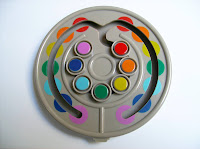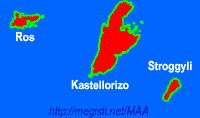Rudenko Disc
Share
For years, Russians have been known for creating many extraordinary things, and mechanical puzzles are certainly among them. Since I started my collection, I've seen some great classic puzzles coming from Russia, particularly from the 80's. However, the puzzle I have here is very recent, released in April 2011, and it's as equally brilliant as its older predecessors.
(Click to Enlarge)
The Rudenko Disc, a Sequential Movement puzzle (more specifically, Gray Code) invented by Valery Rudenko, will be the first of five puzzle reviews in the coming few weeks, all from the Russian game company Roscreative.
(Click to Enlarge)
The puzzle comes in a blister packaging and measures 10cm (about 4") in diameter, so it's smaller enough to carry around anywhere. It has a transparent cover to protect from dust and consists of a disc with seven colored chips (no stickers) and three sections, each with colored circles indicating the correct order for their corresponding chips. The object is to rearrange the chips, one at a time, by color in any of the three sections. The colors, as you can see for yourself, are ordered just like in a rainbow - from violet to red (smaller to larger bow).
Side note: Did you know that when you see a double rainbow in the sky, the second rainbow has its colors in reverse? - It goes from smaller red bow to larger violet bow, it's wider than the main rainbow and it's also dimmer.
Back to the Rudenko Disc... The mechanics of the puzzle are easy to understand, but can take some time to master. The puzzle is set to develop an algorithmic way of thinking, while promoting logic and creative skills. It takes a minimum of 127 movements to get all chips from one section to another. To get to that number, all it takes is a simple formula "2n-1", where n is the number of chips -> 27-1=127.
Sequential puzzles date back, at least from a couple of centuries ago, when French mathematician Édouard Lucas invented the Tower of Hanoi puzzle in 1883. The Rudenko Disc is a little different though, because it has some movement restrictions. The chips can move only to their correspondent color circles in any desired section, but can't move any further. For example, a yellow chip can pass through the red and orange circles until it's blocked when it reaches its yellow circle. Beyond that point, it's useless to force any more movement. Perhaps a more similar concept is the Panex puzzle, which also uses some movement restriction.
The particular movement characteristics of the Rudenko Disc are what makes it so interesting. When I first started playing with it, I didn't know exactly how the puzzle worked, so I was pleasantly surprised to find out that it had more to it than I was expecting. The chips move from one section to another to their correspondent color circle and you feel them click into place by some sort of clever locking mechanism that prevents them from going further than they're supposed to.
Since I had previously solved a few sequential movement puzzles, it wasn't so hard solving this one, although it took me about 15 minutes to solve it in my first attempt. Now, after a little more practicing, I can do it in under 5 minutes. Once you understand the method to get the chips from one section to another, all it takes is some coordination and attention so you won't lose your chain of thought. When you master these skills, it's just a matter of keep practicing to see how fast you can solve it.
The puzzle comes with instructions and an algorithm to move the chips from the middle section to the left section, unfortunately they are all in Russian. Nevertheless, I was sent English instructions as well and this way, the algorithm is understamble. If you don't get yours in English, just send me an e-mail and I'll send you a scan of mine.
From what I gathered, there's only one European online store that sells most of the Rudenko puzzles, which is Hendrik Haak's Puzzle Shop, in Germany. I believe the Roscreative website only takes wholesale orders, but you can send them an e-mail and ask for a quote.
Now available on PuzzleMaster as well.
Update (March 16): I was told that there is an online Russian store that sells all Rudenko puzzles and has international shipment. The website is all in Russian, but you can check here its English translation. Unfortunately, they don't accept Paypal, but you can pay by credit card or bank transfer.
Here's a video made by Roscreative about the Rudenko Disc.
Closing Comments:
The Rudenko Disc is a very welcoming addition to the sequential puzzles category. Its original and appealing design makes it one of a kind and its fascinating concept with the locking mechanism is definitely a joy to play with.
Links:
English translation of Rudenko Disc's page
English translation of Roscreative website
Russian Magazine Article about Valery Rudenko (English Translation)
Russian Newspaper Article about Valery Rudenko (English Translation)
Side note: Did you know that when you see a double rainbow in the sky, the second rainbow has its colors in reverse? - It goes from smaller red bow to larger violet bow, it's wider than the main rainbow and it's also dimmer.
Back to the Rudenko Disc... The mechanics of the puzzle are easy to understand, but can take some time to master. The puzzle is set to develop an algorithmic way of thinking, while promoting logic and creative skills. It takes a minimum of 127 movements to get all chips from one section to another. To get to that number, all it takes is a simple formula "2n-1", where n is the number of chips -> 27-1=127.
(Click to Enlarge)
Sequential puzzles date back, at least from a couple of centuries ago, when French mathematician Édouard Lucas invented the Tower of Hanoi puzzle in 1883. The Rudenko Disc is a little different though, because it has some movement restrictions. The chips can move only to their correspondent color circles in any desired section, but can't move any further. For example, a yellow chip can pass through the red and orange circles until it's blocked when it reaches its yellow circle. Beyond that point, it's useless to force any more movement. Perhaps a more similar concept is the Panex puzzle, which also uses some movement restriction.
The particular movement characteristics of the Rudenko Disc are what makes it so interesting. When I first started playing with it, I didn't know exactly how the puzzle worked, so I was pleasantly surprised to find out that it had more to it than I was expecting. The chips move from one section to another to their correspondent color circle and you feel them click into place by some sort of clever locking mechanism that prevents them from going further than they're supposed to.
(Click to Enlarge) - Solved in Section 2
Since I had previously solved a few sequential movement puzzles, it wasn't so hard solving this one, although it took me about 15 minutes to solve it in my first attempt. Now, after a little more practicing, I can do it in under 5 minutes. Once you understand the method to get the chips from one section to another, all it takes is some coordination and attention so you won't lose your chain of thought. When you master these skills, it's just a matter of keep practicing to see how fast you can solve it.
The puzzle comes with instructions and an algorithm to move the chips from the middle section to the left section, unfortunately they are all in Russian. Nevertheless, I was sent English instructions as well and this way, the algorithm is understamble. If you don't get yours in English, just send me an e-mail and I'll send you a scan of mine.
(Click to Enlarge) - Solved in Section 1
From what I gathered, there's only one European online store that sells most of the Rudenko puzzles, which is Hendrik Haak's Puzzle Shop, in Germany. I believe the Roscreative website only takes wholesale orders, but you can send them an e-mail and ask for a quote.
Now available on PuzzleMaster as well.
Update (March 16): I was told that there is an online Russian store that sells all Rudenko puzzles and has international shipment. The website is all in Russian, but you can check here its English translation. Unfortunately, they don't accept Paypal, but you can pay by credit card or bank transfer.
Here's a video made by Roscreative about the Rudenko Disc.
Closing Comments:
The Rudenko Disc is a very welcoming addition to the sequential puzzles category. Its original and appealing design makes it one of a kind and its fascinating concept with the locking mechanism is definitely a joy to play with.
Links:
English translation of Rudenko Disc's page
English translation of Roscreative website
Russian Magazine Article about Valery Rudenko (English Translation)
Russian Newspaper Article about Valery Rudenko (English Translation)




































5 comments:
I was amused to discover that the given solution has 135 moves, 8 more than is required.
Nick
That's odd. I checked my English instructions and they have a 127 step ideal solution, but my original Russian instructions have indeed those 135 steps. If by any chance you want the 127 step solution, send me an e-mail and I'll get you a scan of mine.
Actually the optimal solution is only 79 moves. Unlike normal hanoi, you can put 'larger' disks on top of 'smaller' ones, and so take shorter route. Four disks can be done in 13 moves:
Move 1&2 to peg 3 (3 moves)
Move 3&4 to peg 2, reversing order (2 moves)
Move 1&2 to peg 1 (3 moves)
Move 3&4 to peg 3, correcting order (2 moves)
Move 1&2 to peg 3 (3 moves)
Thanks Jaap! That's good to know. I guess not even the designer thought of that, because the solution has 127 steps. I'm a little confused, though. When you say you can put larger disks on top of smaller ones, you do know that the puzzle restricts your movements, right? For example, the yellow disk can't go any further than its own color, and they can't be physically removed.
Yes. In the the normal hanoi, disk n can have at most n-1 disks on top of it, but that can only be if they are all in order of decreasing size.
With this puzzle, the movement restriction enforces the fact that disk n can have at most n-1 disks on top of it, as there simply is no room for more, but does not enforce anything about their size, including whether or not it includes disks larger than n.
In my 4-disk example above, I put disk 4 on top of disk 3, which leaves one remaining space above that, because disk 3 (yellow) has room for two disks above it. That space is just enough room to allow the remaining 2-disk tower to be transferred to between the other two places.
Post a Comment